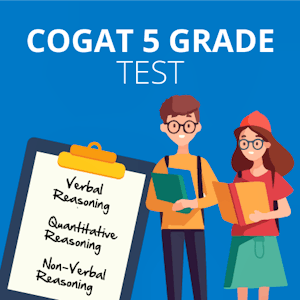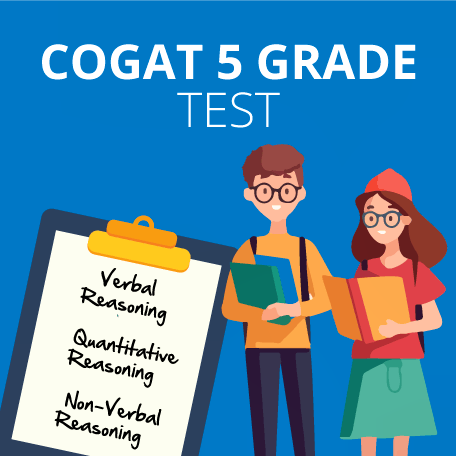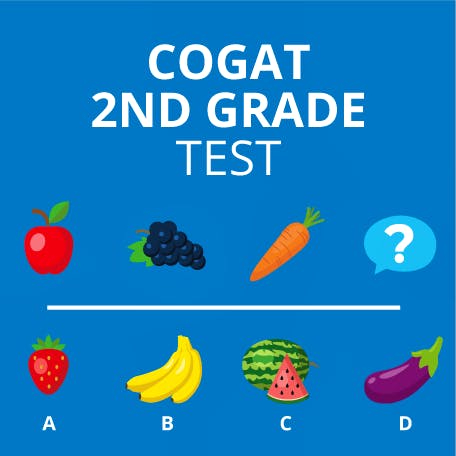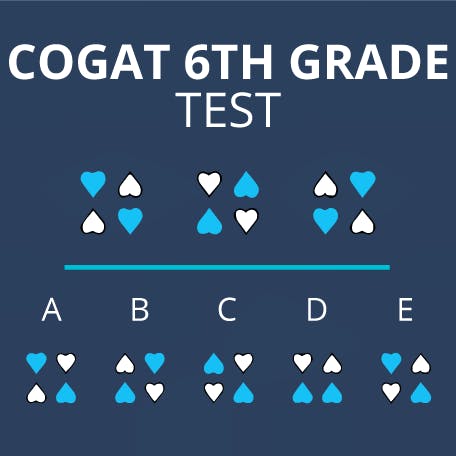A Full Guide to the CogAT Test 5th Grade: Examples & Tips
Updated February 22, 2024


What Is the CogAT 5 Grade Test?
The Cognitive Abilities Test (CogAT) is a widely used standardized test designed to assess your child’s cognitive abilities in various areas.
The CogAT 5th Grade Level is specifically tailored for students in the 5th grade and measures their abilities in three main cognitive areas:
- Verbal Reasoning
- Quantitative Reasoning
- Non-Verbal Reasoning
CogAT test 5th grade questions are also often used by schools and educators to help identify students for gifted and talented programs.
It provides insights into a student's cognitive strengths and weaknesses, helping educators make more informed decisions about educational placement and support.
The test is also advantageous for students whose first language is not English, given its reduced emphasis on verbal skills.
It's important to note that there are different levels of the CogAT, each designed for a specific grade range.
The 5th Grade Level is intended for students in the 5th grade, and the content and difficulty of the test are aligned with the cognitive abilities expected at that grade level.
Unlike earlier school tests, there are fewer images, with the verbal and quantitative batteries containing none.
The nonverbal battery format is similar to the lower levels.
This shift accommodates students' improved focus and endurance in later grades.
Nevertheless, adequate CogAT 5th grade test practice is strongly recommended for tackling challenging questions effectively.
What Subjects Are Tested on the CogAT 5 Grade Test?
CogAT test 5th grade questions assess cognitive abilities across three main areas, each corresponding to a different test battery.
These areas are:
1. Verbal Battery
- Verbal Classification – Students are asked to identify which word in a set does not belong with the others based on verbal characteristics.
- Sentence Completion – This task involves completing a sentence with the most appropriate word or words.
- Verbal Analogies – Students are presented with pairs of words and asked to identify a third word that is related to the pair in the same way.
2. Quantitative Battery
- Number Analogies – Students identify a number relationship and then apply the same relationship to a different pair of numbers.
- Number Puzzles – Students complete number sentences or equations by filling in the missing number.
- Number Series – Students identify the pattern or rule governing a sequence of numbers and then extend the sequence.
3. Non-Verbal Battery
- Figure Matrices – Students identify the missing part in a matrix of geometric designs or symbols.
- Paper Folding – Students determine how a folded and hole-punched piece of paper will appear when unfolded.
- Figure Classification – Students identify the figure in a set that does not belong based on non-verbal characteristics.
How Are CogAT 5th Grade Test Questions Scored?
The scoring of the CogAT test 5th grade questions involves a combination of raw scores, standard scores, and percentile ranks.
Here's an overview of the key components of CogAT scoring:
Raw Scores
Raw scores represent the number of correct responses a student provides on each subtest.
Each subtest within the Verbal, Quantitative, and Non-Verbal Batteries contributes to the overall raw score.
Standard Scores
Standard scores are derived from the raw scores and are used to compare a student's performance to a normative group.
The average standard score is typically set at 100, with a standard deviation of 15.
Higher standard scores indicate above-average performance, while lower scores indicate below-average performance.
Percentile Ranks
Percentile ranks indicate the percentage of students in the normative group who scored at or below a particular score.
For example, a percentile rank of 75 means that the student performed as well as or better than 75% of the normative group.
Stanine Scores
Stanines (standard nines) are another way to represent a student's performance relative to the normative group.
Stanines range from 1 to 9, with a stanine of 5 considered average. Scores in stanines 1 to 3 are below average, 4 to 6 are average, and 7 to 9 are above average.
Age and Grade Percentile Ranks
The CogAT also provides percentile ranks based on a student's age and grade.
These percentile ranks compare a student's performance to others of the same age or grade level.
It's important to note that the CogAT is not a test of achievement but a measure of cognitive abilities.
The results are intended to help educators understand a student's cognitive strengths and weaknesses.
The scores can be used for various purposes, including identifying students for gifted and talented programs, guiding instructional planning, and informing educational placement decisions.
Interpretation of CogAT scores should be done in conjunction with other relevant information about the student.
If you want 12-month access to all the practice resources for this test, our partner TestPrep-Online.com offers a Family Membership.
Family Membership gives you access to all the TestPrep-Online resources for the next 12 months. You will also get two separate accounts, which can be very helpful if you have two children preparing for their tests.
How to Prepare for the CogAT 5th Grade Test
Preparing for the CogAT (Cognitive Abilities Test) for 5th grade involves a blend of academic preparation, mental readiness, and logistical planning.
Here’s how to ensure your child is well-prepared for the test:
Step 1. Understand the Test Structure
Familiarize yourself and your child with the CogAT format. The CogAT assesses verbal, quantitative, and non-verbal reasoning skills across various question types. Knowing the structure ahead of time can reduce test-day anxiety.
Step 2. Academic Preparation
- Use practice tests and workbooks. Practice materials specific to the CogAT can help your child become comfortable with the types of questions they will encounter. Start with a practice test to identify strengths and areas for improvement.
- Focus on weak areas. Once you've identified which sections (verbal, quantitative, non-verbal) your child finds challenging, concentrate on those areas without neglecting the others.
- Incorporate learning into daily activities. Enhance verbal skills through reading and discussion, quantitative skills through math games and puzzles, and non-verbal skills through logic puzzles and spatial reasoning games.
Step 3. Mental and Physical Readiness
- Encourage a growth mindset. Help your child understand that intelligence and abilities can be developed with effort, learning, and persistence.
- Ensure they get enough rest. A good night's sleep is crucial before test day to ensure your child is alert and ready.
- Maintain a healthy diet. Balanced nutrition, including a good breakfast on the day of the test, can affect concentration and performance.
Step 4. Practical Tips
- Practice test-taking strategies. Teach your child how to manage their time effectively, use the process of elimination, and handle questions they find challenging by making educated guesses or moving on to save time.
- Familiarize with the test environment. If possible, visit the test location ahead of time or discuss what the day will look like to minimize nerves.
- Stay positive and supportive. Emphasize effort over outcome and reassure your child that the CogAT is just one measure of their abilities.
Step 5. The Night Before and Day of the Test
- Prepare all necessary materials. Ensure your child has everything they need for the test, such as pencils, an eraser, and a watch (if allowed), ready the night before.
- Arrive on time. Aim to arrive at the testing location with plenty of time to spare to avoid any last-minute stress.
Step 6. After the Test
- Discuss the experience. Talk about what was learned from preparing for and taking the test, focusing on the effort put in rather than the outcome.
- Review the results constructively. When you receive the results, use them to celebrate strengths and identify areas for growth without placing undue pressure on your child.
The CogAT (Cognitive Abilities Test) assesses students' reasoning abilities in verbal, quantitative, and non-verbal areas. It's used to identify students' learning strengths and weaknesses, helping educators tailor instruction to meet individual needs.
Preparation involves familiarizing your child with the test format through practice tests, focusing on areas of improvement while reinforcing strengths, and developing good study habits. Encourage problem-solving and critical thinking in everyday situations to enhance their cognitive skills.
While the CogAT provides valuable insights into your child's cognitive abilities, it's one of many tools used to understand their learning profile. It should not be seen as a sole indicator of academic success or intelligence.
Yes, you can support your child by providing practice materials, creating a conducive study environment, and encouraging a positive attitude towards learning and testing. Engage in activities that stimulate critical thinking and problem-solving skills.
Ensure your child has a good night's sleep before the test, eats a healthy breakfast, and arrives on time. Remind them to stay calm, read questions carefully, and manage their time effectively during the test.
Final Thoughts
As you and your child embark on the journey of preparing for the CogAT (Cognitive Abilities Test) for 5th grade, it’s important to keep perspective. This test assesses reasoning skills in verbal, quantitative, and non-verbal domains, offering insights into your child's cognitive abilities relative to their peers. Preparation can indeed improve familiarity and comfort with the test format, potentially enhancing performance, but it should be balanced with the understanding that the CogAT measures innate abilities rather than academic achievement.
Encourage a healthy study routine that includes regular practice sessions, utilizing available resources such as practice tests, workbooks, and online tools tailored for the CogAT. Focus on areas where your child shows less confidence, but also reinforce their strengths. Remember, the goal is not just to prepare for a test but to nurture a well-rounded intellectual curiosity and problem-solving ability.
Moreover, maintain an open dialogue with your child about the test, ensuring they understand its purpose without feeling undue pressure. Emphasize the test's role as just one of many tools used to support their learning journey, not a definitive measure of their intelligence or potential.
Lastly, ensure your child gets plenty of rest before the test, eats a healthy breakfast the day of, and goes into the test with a positive mindset. Your support, encouragement, and perspective can make a significant difference in their test experience and overall attitude towards learning and assessment.













